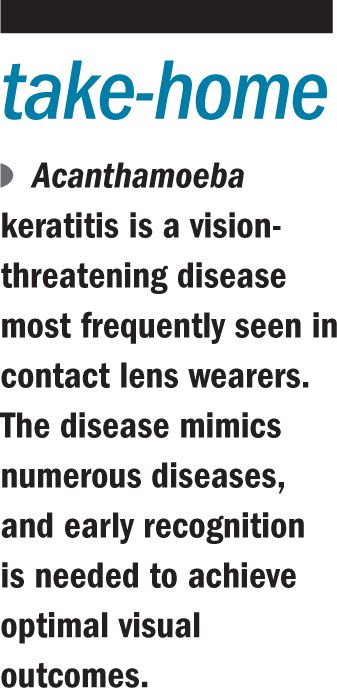Article
Addressing challenges of Acanthamoeba keratitis
Acanthamoeba keratitis is a vision-threatening disease most frequently seen in contact lens wearers. The disease mimics numerous diseases, and early recognition is needed to achieve optimal visual outcomes.
Reviewed by Elmer Y. Tu, MD

Glenview, IL-Acanthamoeba keratitis might be a rare corneal disease, but its deleterious impact on vision and incapacitation of the patient cannot be over-emphasized.
The potential for severe visual loss, substantial associated pain, and lengthy period of therapy exists.
However, timely recognition, establishment of a specific diagnosis, and rapid aggressive therapy are keys to the best possible outcomes in this patient population, said Elmer Y. Tu, MD.
Related: Prompt attention vital to managing severe corneal infections
Delayed recognition is the most common controllable factor leading to a poor outcome, said Dr. Tu, professor of clinical ophthalmology, University of Illinois Eye and Ear Infirmary, Glenview, IL.

Recognition often is delayed, Dr. Tu pointed out, because Acanthamoeba is rarely acute, but rather presents as a subacute or chronic parasitic infection that primarily affects the cornea, mimicking closely the presentation of noninfectious disorders, such as dry eye and non-specific epithelipathies, or other subacute infections like fungi, microsporidia, and herpes.
Recent: Gauging ganciclovir gel for herpes virus
“Most patients are treated first for other diagnoses, which delays recognition and appropriate treatment for weeks or even months,” Dr. Tu said. “It is critical that physicians understand the risk factors associated with Acanthamoeba keratitis, because it can look like anything else.”
Importantly, most cases of Acanthamoeba keratitis develop in patients who wear contact lenses, with the incidence rates the same between hard and soft lenses, and 7% to 11% of patients can have bilateral disease.
Interestingly, the risk of development of Acanthamoeba keratitis in the United States has increased significantly over the past 10 years.
Related: How photoactivation may be the answer for keratitis
“The reason that recognition is so important was demonstrated in our 2007 study in which the main prognostic factor that determines the visual outcome is the anatomic level of the disease,” Dr. Tu said.
He and his colleagues reported in Ophthalmology(2008;115:1998-2003) that the disease stage at presentation in our first 65 patients was 10 times more likely to have a worse visual outcome if the presence of Acanthamoeba went unrecognized in its early stages.
More: Why infections related to PK require intense vigilance
The prognosis is guarded in the presence of deep stromal keratitis, ring infiltrates, and extracorneal inflammation. In contrast, the prognosis is good when findings are restricted to epitheliitis, or anterior stromal disease with or without radial neuritis.
Specific diagnosis
Specific diagnosis
When Acanthamoeba keratitis is suspected, available diagnostic techniques can point to a definitive diagnosis.
A few clinical characteristics-such as radial keratoneuritis or a stromal ring infiltrate-are likely the first things that physicians will look at. Specific microbiologic methods that are not part of standard corneal culturing techniques for suspected infectious keratitis include use of charcoal yeast or nonnutrient agar with an Enterobacter aerogenes overlay, histologic stains, corneal biopsy, and polymerase chain reaction detection.

More: Why fungal infections after keratoplasty are becoming more common
Confocal microscopy, Dr. Tu said, is highly predictive of the presence of the pathogen regardless of the use of culturing and/or microbial methods, with good positive and negative and predictive values in their hands. Some studies have reported lower than desired sensitivity and specificity values, but he commented that these values might reflect the operator- and interpreter-dependent nature of the technology.
Related: Analyzing Acanthamoeba contact lens danger
Medical therapy
The therapeutic choices depend on the complexity of the case, according to Dr. Tu.
“Our standard practice is debridement,” he said. “We usually provide a combination of medications including propamidine and biguanides, either polyhexamethylene biguanide or chlorhexidine, that are instilled hourly until some improvement is seen.”
Patients might receive systemic medications if needed.
In addition, steroids are stopped or curtailed when Acanthamoeba keratitis is suspected or diagnosed.
He cautioned physicians to be alert to the possibility of drug adverse effects that can worsen the patients’ pain especially with the diamidines, propamidine, and hexamidine.
Visual outcomes
Visual outcomes
Dr. Tu reported that the overall visual results tend to be “quite good.” In patients with epithelial disease, their chances of achieving 20/25 or better vision are good.
However, despite therapy, as many as 5% of patients can continue to test culture positive for the pathogen.
More: When is crosslinking appropriate?

In such patients, physicians can increase the dosage of the topical drugs by increasing the concentrations, adding medications, or changing medications. Therapies can fail because of drug resistance, polymicrobial infection, infectious and noninfectious inflammatory sequelae, neurotrophic epithelial disease, and require surgical management.
Secondary drugs include voriconazole, pentamide and, potentially, benzalconium chloride (BAK)-containing compounds. Voriconazole is an anti-fungal agent that targets the cell wall of the Acanthamoeba cyst, and the drug might be beneficial for some patients when administered topically and systemically as adjunctive therapy in patients unresponsive to normal therapy.
Related: Ocular surface unfriendly to pathogenic bacteria
Other agents include, miltefosine, approved in 2014 by the FDA for treating leishmaniasis, has anti-Acanthamoeba activity, as does pentamide when administered intravenously to reduce the risk of recurrence of Acanthamoeba in patients undergoing corneal transplantation.
Administration of other antimicrobial drugs might be beneficial in some patients who harbor co-pathogens, such as herpes simplex, fungal or bacterial pathogens, or other protozoa, Dr. Tu noted.
“If use of an anti-bacterial drug is desired, we recommend one that uses BAK,” he said. “Based on our studies, the fluoroquinolones, by themselves, do not have a substantial anti-Acanthamoeba effect, but BAK does.”
Surgical therapy
Corneal transplantation can be effective for these patients, with increasing availability of medical anti-Acanthamoeba therapy. Collagen crosslinking is a potential option as an adjunctive therapy in very selected cases, but more needs to be learned about its effectiveness and role in treating Acanthamoeba keratitis.
“Acanthamoeba keratitis is the best characterized form of ocular parasitic infection,” Dr. Tu said. “Contact lens wear is the primary risk factor, but is not an exclusive disease of contact lens wearers. Regardless, any contact lens-related keratitis that responds poorly to standard antibacterial therapy should be considered a possible case of Acanthamoeba keratitis.”
More: Tracking the best treatment for fungal keratitis
Elmer Y. Tu, MD
E: etu@uic.edu
This article was adapted from Dr. Tu’s presentation at Cornea Subspecialty Day during the 2015 meeting of the American Academy of Ophthalmology. Dr. Tu has no financial interest in the subject matter.
Newsletter
Don’t miss out—get Ophthalmology Times updates on the latest clinical advancements and expert interviews, straight to your inbox.





